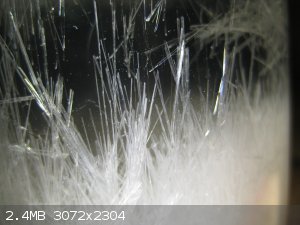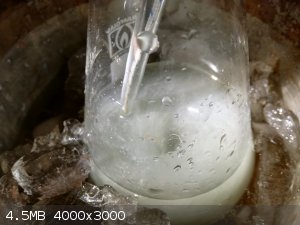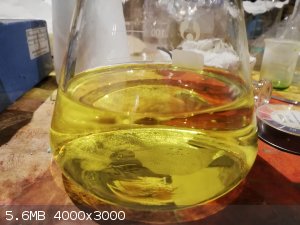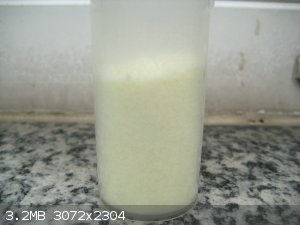Diachrynic
Hazard to Others
  
Posts: 219
Registered: 23-9-2017
Location: western spiral arm of the galaxy
Member Is Offline
Mood: zenosyne
|
|
An improved synthesis of aminoguanidine bicarbonate
I have searched the forum for this procedure and havent't found anything, but if it has been posted before I'm sorry. So far I have only seen people
use the reduction of nitroguanidine in acetic acid with zinc dust for making aminoguanidine bicarbonate. However many people have claimed the process
rather low yielding, very exothermic (hard to control) and a pain to work with due to the pasty nature of the nitroguanidine/zinc mixture.
This process is an improvement to that process. Not only is the molar ratio of zinc to nitroguanidine not 5/1 as it was, but 3.3/1, saving on zinc,
but also none of the reactants are a paste, you just add the zinc as dry powder and the mixture is easily stirable. Thirdly the reaction is much less
exothermic and can be easily moderated by a small ice bath.
This process is based on US2537328 and reduces nitroguanidine in a water suspension with dissolved ammonium sulfate to which zinc powder is slowly
added. Afterwards the zinc sludge is filtered off, remaining zinc is complexed with ammonia and sodium bicarbonate precipitates the aminoguanidine
bicarbonate over the course of several hours.
Chemicals:
Zinc powder (<40 µm, 99.995%)
Ammonium sulfate (>99%)
Nitroguanidine (recrystallized once from boiling water)
Sodium bicarbonate (food grade)
Ammonia solution (25%, pure)
Distilled water
Procedure:
41.14 g zinc powder (629 mmol, 3.3 molar eq.) are weighed and put to the side. Into a reaction flask of at least 500 mL are put 20.00 g nitroguanidine
(192 mmol, 1 molar eq.) and 47.62 g of ammonium sulfate (360 mmol, 1.88 molar eq.) in 285 mL of water. The suspension is stirred and not everything
dissolves, this is expected. The reaction flask is immersed in an ice bath and equipped with magnetic stirring and a thermometer. Stirring is started.
Once the solution reaches 10 °C the addition of small spatulas of zinc powder at a time is started. Monitor the exotherm and don't add too much at
once, however the reaction is fairly easy to control. 3-4 spatulas of zinc can be added at a time, making the temperature jump up by 5-8 °C. The
reaction was kept between 5-15 °C, leaning to the latter temperature. The complete addition of zinc took about 1 hour, during which the ice bath was
refilled just once. Afterwards the reaction was left stirring at about 15 °C for a further 30 minutes. The pH rose to about 8-9. Using a fritted
vacuum filter the zinc oxide sludge was removed, it filtered fairly easily. The yellow colored filtrate is put into a flask with magnetic stirring,
and 8.57 g of 25% ammonia solution (126 mmol, 0.66 molar eq.) are added as well as 28.57 g of sodium bicarbonate (340 mmol, 0.94 molar eq.) with
stirring, it dissolves after a short while. The solution is left standing for 12 h during which the aminoguanidine bicarbonate slowly precipitates.
Afterwards the product is vacuum filtered off and air dried.
Yield of aminoguanidine bicarbonate: 15.700 g (115 mmol, 60% based on nitroguanidine)
Pictures:
Recrystallized nitroguanidine:

Reaction mixture:

The yellow filtrate with ammonia and sodium bicarbonate left to crystallize:

Final slightly yellow product:

Additional notes:
Adding ammonia in the last step likely serves to keep soluble zinc in solution.
The literature yield about 77%.
The process was also attempted on a smaller scale (3.5 g) for just 1 hour with less pure nitroguanidine, the yield was 41%. The product however was
also fully white without a trace of yellow coloration.
This procedure can be probably optimized further. Patent US1990511 uses zinc acetate instead of ammonium sulfate and also a copper sulfate solution as
catalyst. They claim a yield of "90% of the weight of nitroguanidine", which I guess corresponds to a 69% molar yield. The reaction temperature and
time might still be improved upon. Maybe an excess of sodium bicarbonate would help the precipitation. And perhaps the yield can be further improved
by keeping the pH in a suitable window, whichever that might be.
Sources:
Main source is patent US2537328 as attached below
Attachment: Aminoguanidine_from_nitroguanidine_with_Zn_ammonium_sulfate_US2537328.pdf (280kB)
This file has been downloaded 493 times
Secondary source is patent US1990511 also attached below
Attachment: Aminoguanidine_from_nitroguanidine_with_zn_acetate_US1990511.pdf (291kB)
This file has been downloaded 418 times
[Edited on 28-6-2020 by Diachrynic]
we apologize for the inconvenience
|
|
|
Tsjerk
International Hazard
    
Posts: 3022
Registered: 20-4-2005
Location: Netherlands
Member Is Offline
Mood: Mood
|
|
Cool, I'm getting some guanidine bicarbonate soon. I will make some nitroguanidine via the nitrate of guanidine and then use this write up to make
aminoguanidine! Thanks
|
|
|
roXefeller
Hazard to Others
  
Posts: 463
Registered: 9-9-2013
Location: 13 Colonies
Member Is Offline
Mood: 220 221 whatever it takes
|
|
I did a workup of this yesterday and precipitated overnight. Both trials were with 1.0 g of nitroguanidine. Since the H2SO4 acid from the
nitroguanidine was only dilute catalyst of known quantity, I added a stoichiometric amount of 10% ammonia to form the ammonium sulfate salt, and
enough water to reach the needed concentration.
1g Nitroguanidine
2.381g ammonium sulfate in 14.25 g water
2.057 g powdered zinc
I cooled the aqueous ammonium sulfate to 10C in an ice bath with stirring. And added the nitroguanidine. I added portionwise, keeping it between 10C
and 13C, with later additions allowing for a delayed temperature rise. After the last addition it continued stirring for another 30 minutes. It was
filtered to remove the zinc sludge. 1.07g 10% ammonia solution were weighed into another beaker. I used a transfer pipette to pull the liquid off
the filtrate and leave the heavy, superfine sediment that escaped the filter. This was added to the ammonia, stirred and 1.425g NaHCO3 was added.
Stirred again and left overnight. After filtering, the yield plus filter were 1.32g, filter was 0.88 so the total yield was 0.44g, 61.8% of
theoretical.
The second workup only changed the zinc quantity to 2.25g, and slowed the pace of additions. Then left to stir for another couple hours. Same
ammonia and bicarbonate. Yield plus filter were 1.25g, filter is 0.88g, yield is 0.37g 52% yield.
Any idea what effect the copper sulfate could have as a catalyst? What does it do in solution?
[Edited on 31-12-2020 by roXefeller]
One must forego the self to attain total spiritual creaminess and avoid the chewy chunks of degradation.
|
|
|
Diachrynic
Hazard to Others
  
Posts: 219
Registered: 23-9-2017
Location: western spiral arm of the galaxy
Member Is Offline
Mood: zenosyne
|
|
Hey roXefeller, glad to see you had success with the synthesis! Even had a similar yield to me, even tho you worked on a considerably
smaller scale. That is nice to see.
I'm not sure if copper sulfate would act as a catalyst, but I wouldn't be surprised. For example, when performing marsh's test for arsenic, some
copper sulfate is added to the zinc. The zinc is reducing the copper, forming a partial coating on the zinc granules. This forms a local element where
the zinc is going into solution and the electrons flowing through the metal into the copper, reducing H(+) to H2 gas there. This is supposed to lower
the hydrogen overpotential and make it easier for H2 to form. That's for marsh's test tho and I am not sure if it would help here. The reaction seems
to work quite well without any copper.
[Edited on 15-2-2021 by Diachrynic]
we apologize for the inconvenience
|
|
|
Industrial Adhesive
Harmless

Posts: 15
Registered: 30-11-2018
Location: to be honest, I lost track
Member Is Offline
|
|
very nice! i enjoyed reading your write up. out of personal curiosity what is your prefered method of synthesizing aminoguanidine bicarbonate? this
seems to have better yields over the cyanamide and hydrazine hydrate method. but is it as replicatible as the before mentioned method? also i am
intrested in how the zinc powder mesh size will affect yield. but great job tho!
|
|
|
|